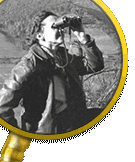Caption: Juniata River near Lewistown, 1873, by George Hetzel (1826-1899). Born in Alsace, France in 1826, Hetzel came to Pittsburgh when he was two. He was apprenticed to a house and sign painter when he was a young boy and later gained experience as a muralist for riverboats and cafes. He joined a group of Pittsburgh painters, at the mountain retreat called Scalp Level, where he began to paint landscapes. Considered one of Pennsylvania's most significant landscape, portrait, and still life painters of the nineteenth century, Hetzel painted highly detailed, realistic views of nature and used impressionistic techniques with light.
Courtesy of the State Museum of Pennsylvania, Pennsylvania Historical and Museum Commission Gift of Miss Dorothy Kantner, Somerset
(Artist's granddaughter)
Caption: I Will Lift Up Mine Eyes, n.d. Lithograph, by Julius Bloch.
Bloch describes his work, "Most of my work deals with Negroes and their lives. For more than fifteen years I have been observing the Negro population of Philadelphia, attracted by the rich color, rhythmic movement, laughter, and religious fervor so characteristic of the race. Hundreds of notes, made from life in districts where Negroes predominate, fill many of my sketchbooks. These I have frequently used in making compositions for paintings and lithographs. Most of my people have been humble workers, ditch-diggers, hodcarriers, bootblacks, ragpickers, washerwomen, household workers, parkbenchers, preachers, and an occasional tap dancer, boxer, or saxophone player. Each one I selected because I found him or her not only typical of the race, but also revealing in character and bearing the complex problems which are the by-product of life in a large, densely populated city."
Courtesy of the State Museum of Pennsylvania, Pennsylvania Historical and Museum Commission, Gift of Benjamin Bernstein
Caption: Landscape, (Poconos) by Walter E. Baum, 1944. Born in Bucks County, 1884, Walter Emerson Baum painted the Pennsylvania landscape in the styles of impressionism and American realism. Baum studied at the Pennsylvania Academy of Fine Arts under Daniel Garber, William Trego, and Thomas Anshutz, winning the Jennie Sesnan gold medal in 1925.
Courtesy of the State Museum of Pennsylvania, Pennsylvania Historical and Museum Commission, Gift of Louise E. Knoll
Caption: Self Journey Within #27, by Maya Schock, 1972. Maya Schock founded the Doshi Gallery, Harrisburg's first permanent gallery for contemporary art.
Courtesy of the State Museum of Pennsylvania, Pennsylvania Historical and Museum Commission Gift of Benjamin Bernstein
Caption: Untitled Monographic Drawing (#3061) , c. 1970, by Harry Bertoia (1915-1978).
Born in Italy, Bertoia became an American citizen in 1946 and moved to Bally, Pennsylvania, near the Knoll factory and established his own design and sculpting studio. He received the Gold Medal given by the Architectural League of New York (1955-56), the Fine Arts Medal from the Pennsylvania Association of the American Institute of Architects (1963), and an honorary doctorate from Lehigh University in Bethlehem, Pennsylvania (1976).
Courtesy of the State Museum of Pennsylvania, Pennsylvania Historical and Museum Commission Gift of Mara Lesta Bertoia and Wilbur C. Springer, III.
Caption: Born in Philadelphia in 1905, Etting received his education at Harvard University. He later studied painting at the Academie Grand Chaumiere and with Andre Lhote in Paris. He was a U.S. artist delegate to the Second International Congress of Plastic Arts in Dubrovnik, 1957, and held teaching positions at the School of Industrial Art, the Philadelphia Museum of Art, the Philadelphia College of Art, and the Tyler School of Art at Temple University. Etting was an influential member of the Philadelphia Art Alliance, Artists Equity Association, where he served as President from 1955-58), and was also a member of the National Society of Mural painters.
Courtesy of the State Museum of Pennsylvania, Pennsylvania Historical and Museum Commission. Gift of Benjamin Bernstein
Caption: George Papashvily's carved stone sculptures.
Considered a Bucks County artist, Papashvily was born in the former USSR. He was successful as both as a sculptor and as an author.
In his early 40s and having no formal training, Papashvily began carving sculpture directly on wood and on stone, sculpting free standing figures and bas relief. Nature being his favorite subject he carved animals, insects, flowers, and an occasional human figure.
Courtesy of the State Museum of Pennsylvania, Pennsylvania Historical and Museum Commission Gift of Helen Papashvily Estate
Caption: Bronze sculptures of William Penn Meeting with the Indians, by Charles Rudy,, c. 1964. Memorial Hall Gate sculptures inside the State Museum of Pennsylvania.
Born in 1909, in York, Pennsylvania, Rudy studied art education at the Pennsylvania Academy of the Fine Arts. Rudy, a Guggenheim fellow taught as the head of Cooper Union's sculpture department for ten years. He also held teaching positions at the Pennsylvania Academy of the Fine Arts and the Philadelphia Museum School of Art.
Courtesy of the State Museum of Pennsylvania, Pennsylvania Historical and Museum Commission
Caption: Deer Slayer, by N.C. Wyeth, c. 1925.
Courtesy of the State Museum of Pennsylvania, Pennsylvania Historical and Museum Commission Gift of Mrs. George R. Bailey
Caption: Charles Weisgerber's 1893 painting of The Birth of Our Nation's Flag, helped make Betsy Ross the most famous woman in American history. Since no images of Ross existed, Weisgerber created her face from photographs of her daughters and other female relatives.
Courtesy of the State Museum of Pennsylvania, Historical and Museum Commission
Caption: Quilt: Flying Eagle, circa 1870, by Catherine Gudila Burgaman Swengel.
Courtesy of the State Museum of Pennsylvania, Pennsylvania Historical and Museum Commission
Caption: Still life with Tunsian Vase, 1982-83, by Jane Piper.
Courtesy of the State Museum of Pennsylvania, Pennsylvania Historical and Museum Commission





